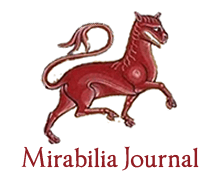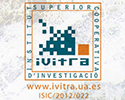The Sacrality of Queen in the Norman Sicily. The pattern of Ordo coronationis
Mirko VAGNONI
Original title: La sacralità della regina nella Sicilia normanna. Il caso dell’Ordo coronationis
Published in Mulier aut Femina. Idealism or reality of women in the Middle Ages
Keywords: Kingdom of Sicily, Normans, Queenship, Representation of Power, Royal Sacrality.
Generally historians have given little attention to the sacrality of the Norman queens of Sicily. Certainly, there are few sources on this subject but this paper wants to study this topic analysing a very important text for the representation of power: the Ordo coronationis written in the Norman Sicily and that describes the ritual for the coronation of a queen.
The Sapientia Christiana and the Analogy of the Liberal Arts in a Sermon of Saint Vincent Ferrer (1350-1419)
Gustavo Cambraia FRANCO, Ricardo da COSTA
Original title: A sapientia christiana e a analogia das artes liberais em um Sermão de São Vicente Ferrer (1350-1419)
Published in
Keywords: Analogical Thinking, Medieval Science, Medieval Sermon, Saint Vincent Ferrer, liberal arts.
This article contains an exposition and an analysis on the theme of the Liberal Arts in a sermon of Saint Vincent Ferrer, renowned Dominican Valencian preacher during the passage between the fourteenth and fifteenth centuries. We intend to show that the Liberal Arts are addressed by the sermonist within the traditional theoretical scope of classification of sciences in the medieval period, as branches of knowledge for the service of the higher science, Theology, to avail the scholastic dictum philosophia ancilla theologiae. In his exposition, the author follows the medieval didactic principles of analogical thinking, the figurative hermeneutics and the allegorical exegesis of the Bible, by which he ensnares the meanings and properties of each science or Liberal Art, namely Grammar, Logic and Rhetoric, the Trivium sciences, and Music, Arithmetic, Geometry and Astrology, Quadrivium sciences, in a web of metaphorical and analogical relations aimed, at the end, to confer spiritual, religious and moral meaning and utility to each of them, as well as subordinate them to the royal domain of the sapientia christiana.
The Scholasticism – considerations about your internal unity and diversity
José D’Assunção BARROS
Original title: A Escolástica – considerações sobre sua unidade e diversidade interna
Published in Monastic and Scholastic Philosophy in the Middle Ages
Keywords: Medieval Culture, Scholasticism, University.
The mainly purpose of this article is to discuss comparatively some historiography positions concerning to the interaction between Scholastic and the social-historical developments of the medieval period, examining this interaction on the point of view from the Cultural History. Among the questions examined, an important point is the relation between Scholastic and University, as also the correspondence between the transformations inside the Scholastic thought and the passages from the medieval period of feudal expansion (XI-XIII centuries) to the feudal crisis from the XIV and XV centuries.
The School of Alexandria and the use of allegorical method by Origen of Alexandria
Eirini ARTEMI
Published in
Keywords: Allegory, Celsus, Neoplatonism, Origen, Platonism, School of Alexandria.
In this paper it will be examined the School of Alexandria. The latter was a great center of Christianity, for a span of five centuries, until the reign of Justinian (529 A.D.). In it, the first system of Christian theology was formed and the allegorical method of biblical exegesis was devised. The School of Alexandria adopted the allegorical interpretation of the Holy Scripture, believing that it hides the truth and at the same time reveals it. It hides the truth from the ignorant, whose eyes are blinded by sin and pride, hence they are prevented from the knowledge of the truth. Origen, one of the greatest Christian theologians employed the allegorical method of the interpretation of the Bible in the belief that he was explaining them, whereas he was exploiting them on behalf his own dogmatic teaching. He was accused of that by other fathers of the Christian Church but also by many heretics. Origen had to defend his exegetical method against the various attacks from heretics, from laymen the church and from Celsus who attacked the Christian writers because, being «ashamed of these things (which are written the Bible), they take refuge allegory». On the other hand, Origen was not a «pure» allegorist in that he has some place for literal interpretation as well. Finally, Origen’s basic commitments were to the Scriptures as the word of God, the church as the guardian of the tradition and the household of faith, and to Platonic metaphysics He thus wanted to hold both to his literally true Christian history, and to his spiritually true Platonism and Neoplatonism.
The Sufi thought in the Rasā’il Iḫwān al-Ṣafā’
Mourad KACIMI
Original title: El pensamiento sufí en las Rasā’il Iḫwān al-Ṣafā’
Published in
Keywords: Philosophy, Rasā’il Iḫwān al-Ṣafā’, Sufí knowledge.
In this article we highlight the basic fundaments of Sufi discipline in religion and philosophy. Similarly, is shown how was employed this type of knowledge and conceptions in a book as the Encyclopedia of Iḫwān al-Safā’, classed inside the philosophical genre. On the other hand, we emphasize the significance and influence of the philosophical ideas of the Iḫwān al-Safā’ in later prominent Sufi scholars.
The Use of Eponyms in Medical Practice
Fleury Marinho da SILVA, Rodolfo Costa SYLVESTRE, José Guilherme Pinheiro PIRES
Original title: O Uso de Epônimos na Prática Médica
Published in
Keywords: Eponyms, Medical Education, Medical Humanities, Terminology.
An eponym is a medical term derived from a person’s name, either real or fictitious. Several authors that stand against the use of eponyms in Biology or Medicine argue that the practice is anti-didactic because it is impossible to memorize over ten thousand existing eponyms, the same eponym may designate two different biomedical entities, or the eponyms can render tribute to infamous physicians. However, there are authors who support their use and describe that its practice is a medical art, reflecting the medical history over the years. For them, the use of eponyms is a correct attitude of recognition and a deserved tribute to those who contributed with their observation and research for developing the medical sciences.
The Virgin Mary, Theotokos, and Christ, true God and true man. The mystery of Incarnation according to Cyril of Alexandria
Eirini ARTEMI
Published in Mulier aut Femina. Idealism or reality of women in the Middle Ages
Keywords: Christ, Christotokos, Cyril of Alexandria, Nestorius, Theotokos, Virgin Mary.
The 5th century controversy of Bishop Nestorius of Constantinople and Bishop Cyril of Alexandria centred on the Person of Jesus Christ: To what extent is Jesus human? To what extent divine? And to what extent and how are His humanity and divinity united? Christ has two natures. Jesus Christ is both fully human and fully divine. If Jesus was only human, Cyril urged, and God was elsewhere, the Incarnation, the Word became flesh (human indeed), would be meaningless. On the other hand Nestorius refused that Jesus is a God too, when he questioned the use of Τheotokos (Θεοτόκος) in the veneration of Mary, the mother of Jesus. This led to a greater dispute about his Christology, specifically, his conception of the unity of the divine and human natures of Christ. In this controversy Cyril of Alexandria became his most outspoken opponent. Cyril underlined that Christ is human and God at the same time. He has two natures in the unity of person (Hypostasis). Cyril emphasized the unity of Christ and his divinity, he held that Christ “was at once God and man,” and without “any mixture or blending.” In this way he preserved the distinction between the two natures which became so important in the definition of Chalcedon. Cyril urged that Jesus Christ is at once God and man, and he is “in the likeness of men” since even though he is God he is “in the fashion of a man”. He is God in an appearance like ours, and the Lord in the form of a slave.
The Way to Heaven: religious instruction in the seventeenth century through Jesuit board games
Adrian SEVILLE
Published in Games from Antiquity to Baroque
Keywords: 17th century, Art History, Board game history, Emblematics, France, Jesuits, Missionaries in Canada, Missionaries in Turkey, Religious instruction.
During the 17th century, French Jesuits adapted the well-known jeu de l’oie (Game of the Goose) for the purposes of religious instruction in their foreign Missions. These games consisted of a series of religious emblems arranged to form a spiral track, the movement of tokens along this being determined by chance, subject to particular rules. The earliest of these games, the Jeu du Point au Point, is analysed in detail, giving historical background and explanation of the emblems and their significance. Two similar Jesuit games are surveyed and compared with other religious games of the period. It is evident that the visual image played a commanding role in Jesuit education.
The World of Dionysus. Visions of bodies in fun in Classical Greece
Manuel ÁLVAREZ JUNCO
Original title: El mundo de Dioniso. Visiones de los cuerpos en diversión en la Grecia Clásica
Published in Rhythms, expressions and representations of the body
Keywords: Dionysus, Festivities, Satyrs, Symposiums, Visual insight.
The figure of the mythical Greek god Dionysus presided over the most playful aspects of classical Hellenic society, whether they were parties, banquets, comedies, or celebrations in general. The visualizations of the scenes of the divinity of wine and orgy, accompanied by his crazy cohort of satyrs and maenads, show the burlesque, critical and comic sense of a culture that laid the foundations of the West. Something as contemporary as today’s graphic humor finds images of its remote origins through the splendid figurative ceramics of the classical Greek period dedicated to this god. This article shows and analyzes some examples of that visual world where the festive, the comic and the conceptually ingenious provide the unveiling of the transgressive universe of Greek society.
The access to Being through Beauty. Notes on the beauty of the world according to Bonaventura
Gerald CRESTA
Original title: El acceso al Ser a través de la Belleza. Notas sobre la belleza del mundo según Buenaventura
Published in Manifestations of the Ancient and Medieval World
Keywords: Beauty, Being, Knowledge of Beauty, Transcendentals.
From the perspective of the transcendental concepts of being, beauty has been submitted to occupy a place that has promote discussions on its legitimacy among the other transcategorial concepts. One aspect of this debate reflects the importance of the beauty in the world as a way of privileged access to understanding of being. Along with the perfect Unity, inescapable from the platonic conception of Ideas, beauty is in the medieval scholastic an order that shines forth in the diverse multiplicity of bodies. In this way, presents a formal intrinsic quality that allows it’s to transmit to perception – sensorial and intellectual – the Intime frame which is the ontological structure of the world. This paper points some distinctive notes of that symbolic nature in the way that is considered under the Bonaventura conception of the world.






















































































